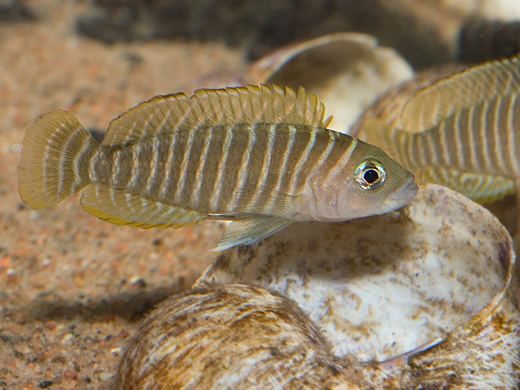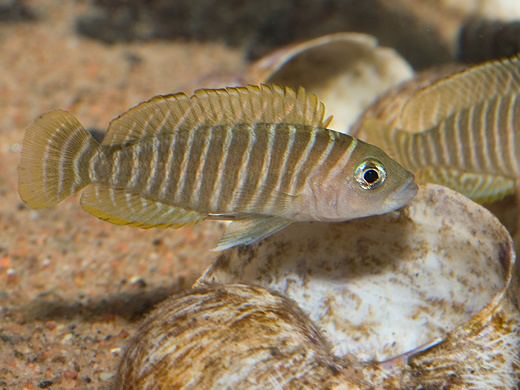The Similis Shelldweller is known from the southern end of Lake Tanganyika, where it is found in large colonies living in empty shells on sand beds in the shallows. In the wild, a colony of females is served by a single male. His colony will be made up of several small empty Neothauma tanganyicense snail shells, in which he entices females to come and take up residence. In certain areas of the lake, these snail shells are found in the most enormous piles. They do not disintegrate because of the hardness of the water, and masses of colonies of these shell-dwellers are found living side by side. The females will spend much of their time in their individual shell; indeed it is here that each female will rest, retreat to when necessary, spawn and raise her young.
Each male will defend his territory of shells and females, all making use of the very natural cover. The tank itself does not have to be particularly large for a small colony, but it must have a soft sand substrate and plenty of empty snail shells on offer (Apple snail shells or escargot shells are usually quickly approved of). The fish will dig around and under the snail shells so that they eventually end up on the tank floor rather than on top of the sand itself, and watching them excavate these little depressions and move sand about the aquarium is fascinating. These fish should never be kept without snail shells (or substitutes such as small PVC elbow tubes). Once spawning has taken place (see below for details), several generations of fish may live together. However, if you intend to keep a large number of the fry, be sure to upgrade the tank for a larger model, or else move some of the fish to another aquarium.
Needless to say, the more fish present, the more shells will be needed. Undergravel filters do not work well with shell-dwelling species, as they do tend to regularly excavate down, even in deeper sand beds. External filter inlets should be covered with a sponge in order to prevent any fry from being drawn in. This sponge should be coarse enough to allow a good flow of water into the filter, but at the same time, of a cell size which will stop the passage of any young into the filter. Unfortunately, planting is not always very successful due to the uprooting behaviour of these fish.
Clean water is essential, so be sure to carry out plenty of regular partial water changes. These fish can be sensitive to changes in conditions, so it is best to ensure that the new (dechlorinated) water is of the same temperature as the tank water, and should be added slowly. In larger aquaria, these fish may be kept with other small and relatively peaceful Tanganyikan cichlids, but the fry survival rate will obviously not be quite so high. Do not use shells with tight narrow spirals, as the females may become trapped
- Species – Lamprologus Similis
- Common Name – Similis Shelly
- Origin – Lake Tanganyika in Africa
- Diet – Carnivore
- PH Range – 7.8 – 9
- Temperature – Tropical 26°c – 27°c
- Breed Type – Egg Layer
- Maximum Size – approximately 4cm
- Sex – Un-sexed




